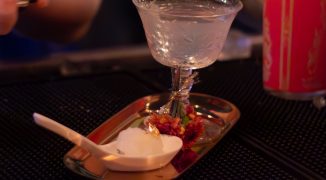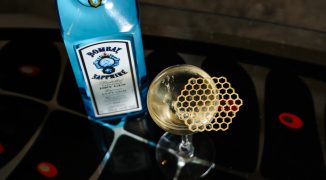When people think about bartending, they consider recipes, coordination, and an ability to get along with people. If they’re smart, they also factor in stamina and an ability to absorb knowledge about everything from history to distillation to the favorite drinks of regular customers. Few people, however, factor in the backstage labor that starts hours before a bar opens: prep. From syrups to garnish, it’s a fact of cocktail life. Every bar and restaurant handles it differently – and each has different needs. Here’s how a few distinctive venues make prep life easier for the bar.
Amor y Amargo (New York City)
Amor y Amargo opened in 2011, with a “no sugar, no shaker, no juice” approach to cocktails, and a framework of Old Fashioneds, Negronis, and Manhattans. The tiny space was constantly busy; bartenders moved from patron to jigger to glass with impeccable courtesy and scarcely an instant to breathe.
In 2016, when the bar marked its fifth anniversary, Sother Teague sat down with Ryan Chetiyawardana and talked about pre-batched cocktails. Chetiyawardana’s crew batches impeccable cocktails at White Lyan in London. It made sense for Amor y Amargo: no juice. “Nothing’s perishable,” Teague says.
Whether it’s an Old Fashioned, a Negroni, or a Manhattan, it can be batched – but “where were we going to put it?” Teague’s voice echoes the question that stalled him at the time. Then, he says, “It wasn’t a problem. Amor y Amargo fills three 750cl bottles with each cocktail. When a bottle’s empty, it’s set aside. When time allows, the bartender batches and refills the bottle, and puts it in the back of the row in the fridge. Patrons still see the bartenders measuring, icing, and garnishing – but something’s changed. “I have time to be a bartender,” Teague says. After years of being heads-down over cocktails, Amor y Amargo’s team can talk with patrons about food, cocktails, and current events. The cocktails come out faster and are – of course, being batched – absolutely consistent. In terms of time, quality, and hospitality, it’s been a positive change: enough that Teague would advocate batching for any busy bar. “Even if you have only one or two Negronis or Manhattans on the menu, it’s going to make a difference.”
Latitude 29 (New Orleans, LA)
Jeff “Beachbum” Berry and Annene Kaye’s NOLA tiki bar, Latitude 29, is about as far from “stirred only” as a bar can be. There are lots of perishables – and when it comes to what’s fresh, Brad Smith (who helps to manage the bar program) says, “we get it in on a daily basis.” Lime, lemon, orange, pineapple, mint, orchid – those come in every day.
Latitude 29 is open seven days a week, and no day is without its barback. The full-timer works from Wednesday through Sunday; the other comes in Monday and Tuesday. At Latitude 29, Derek Smith — the main barback — does the prep.
“Really, he’s more than a barback,” Smith says. “He’s a prep chef.” That wasn’t his background; he started in the company as a dishwasher. Smith describes Latitude 29 as a meritocracy. The dishwasher worked hard enough to warrant a promotion – and he got one that took him to the bar and the kitchen. He didn’t have a background in either. That wasn’t a problem. “His training was entirely in the organization here.”
At Latitude 29, the barback handles all of the standard duties: stocking the bar, set-up and break-down, running ingredients, “but we have masses of work every day that he has to execute.” The includes making juices, syrups, cordials, and house mixes (currently, a honey-butter spice mix and an “Undead” mix). Smith acknowledges that there are advantages to buying bottled juices and extracts: a more stable shelf life, an ability to stock larger quantities, and lower costs – but Latitude 29’s focus on freshness demands dedicated work. That means having a barback who knows his way around not just a juicer, but also a kitchen. The costs in produce, training, and labor pay off in quality, reputation, and customer loyalty.
Nightbell (Asheville, NC)
For Nightbell bartender Phoebe Esmon, prep is far from a new experience. “When I was in Philly, I did at least two days a week of prep for two different bars.” In their business, Spirit Animal, Esmon and her partner, Christian Gaal, build cocktail programs. Esmon has taught cocktail workshops about using preservation techniques in cocktail programs. “Everything from syrups, jams, shrubs, agrodolces . . .” If it can bring life to a cocktail program, then Esmon will make it – and if that sounds like a lot of work, then it’s work to a barkeep’s purpose. “The more prep you do, the less you have to do during service.”
At Nightbell, that experience is put to work. “The bartenders do everything,” says Esmon. “We set up the bar, we break down the bar, we clean the bar, and we do all the things.” During service, there are food runners and service. “When it comes to bar responsibilities, it falls on us.”
“Prep shift is my favorite time of the week,” Esmon says. “I like working in the kitchen – and I learn a lot.” On prep days, she comes in two or three hour before her shift. Cooking’s benefits include control, knowledge, an ability to explore and experiment. Esmon has a theory: “through using a combination of new and old technologies, you can create a very creative bar program at a minimum cost.”
That creativity factors in Nightbell’s teetotal patrons. “I’m revamping the craft soda program,” Esmon says. This season, that involves making a balsamic raisin soda, a muscadine grape, a peach, and a grapefruit. There’s also lime cordial, plus strawberry Sriracha preserve and mango preserve. Early in the summer, Esmon made honeysuckle tincture. “That’s most of it – oh, and the usual stuff, like jalapeno syrup, ginger syrup, whatever else needs prepping.”
Using the kitchen can be a time-saver. “Learn how to use a cryovac machine, if you have one,” Esmon says. She draws on pineapple gum, for pisco punch, as an example. “If you cryovac the pineapple with the syrup, it’s going to take twelve hours to do what four days would have done.”
That’s reason enough to be friends with the kitchen.
Porchlight (New York City)
Porchlight, the Union Square Hospitality Group’s first standalone bar, has been a New York City hotspot since the doors opened. For head bartender, Nick Bennett, whose background includes small craft bars like Booker and Dax, this large cocktails-and-small-bites spot was quite a change. “We’re a pretty high-volume bar,” Bennett says, “and there’s so much movement going through with syrups and citrus. We can seat 170-plus, and we will hit that, more often than not.”
Barbacks make sure that the bartenders have everything they need, “so bartenders can focus on making cocktails and on the guests’ experience.” That said, barbacks and bartenders are responsible for the prep work. “We don’t have anyone dedicated to prep.” Barbacks handle most of it, but all of the bartenders know how to make everything from scratch.
Porchlight’s barbacks have to be on top of their game. “If everyone wants to drink a blue cocktail, then we’re going to run through our cinnamon syrup really fast – and our bartenders can’t stop.”
The menu changes seasonally. “We never do any entirely vast menu change, but we do a cleanup for the summer and the winter.” That sees four to six cocktails change, with hyper-seasonal cocktails and drinks that aren’t selling going away. “For the spring and fall, when there are a ton more new ingredients we can play around with, we’ll do a more substantial menu change – nine or ten, out of our standard twenty-four cocktails.” Those are key times for developing and learning new components, and the barbacks and bartenders have to adapt fast.
When it comes to prep, adaptation is key. “You have to keep honing your skills and continue to grow.” Bennett had to learn to make great cocktails for multitudes, and that meant changing some of his norms. “The thing I’m going to reference is our citrus peel. When we first opened, I wouldn’t even think about cutting our twists beforehand. They had to be fresh, cut immediately before the cocktail gets taken out to the table.” Bennett was thinking like someone running an intimate craft cocktail lounge. At Porchlight, however, “that could not happen at our volume. I swallowed my pride, and we cut them beforehand, and we edged them off.” The pre-cut twists are pristine. If they begin to wither, then they’re replaced, “so that they’re always fresh and ready . . . It cuts an entire five seconds, and gets our cocktails out.” In a little place, five seconds might seem like nothing, but consider Bennett’s perspective: “Five seconds times 800 cocktails – it adds up to a lot of time.” Over an hour. That’s a daunting amount to squeeze out of a piece of citrus.
Whether you’re working in a large restaurant or a cozy cocktail lounge, tailoring prep work can make your shift easier, your patrons happier, and your drinks better – no cryovac required.




